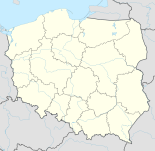Tyniec Legnicki
| Tyniec Legnicki | ||
|---|---|---|
 Help on coat of arms |
|
|
| Basic data | ||
| State : | Poland | |
| Voivodeship : | Lower Silesia | |
| Powiat : | Legnicki | |
| Gmina : | Ruja (Lower Silesia) | |
| Geographic location : | 51 ° 10 ' N , 16 ° 23' E | |
| Residents : | ||
| Postal code : | 59-243 | |
| Telephone code : | (+48) 76 | |
| License plate : | DLE | |
| Economy and Transport | ||
| Next international airport : | Wroclaw Airport | |
Tyniec Legnicki [ 'tɨɲɛt͡s lɛg'nit͡ski ] ( German Groß Tinz ) is a village in the powiat Legnicki in the Lower Silesian Voivodeship in Poland. It belongs to the rural municipality of Ruja and is located on the river Cicha Woda ( Leisebach ), about two kilometers west of Ruja (Royn) and 17 kilometers east of Legnica (Liegnitz) .
history
Groß Tinz was founded under German law and first mentioned in a document in 1316. At that time it belonged to the Duchy of Liegnitz , which in 1329 subordinated itself to the Crown of Bohemia as a fiefdom , which was confirmed in 1335 with the Treaty of Trenčín . On February 3, 1362 it was together with the Vorwerk from Litomyšl Bishop Mathias of Neumarkt acquired the well with weihbischöflichen actions in the diocese of Wroclaw was entrusted. In his will he prescribed Groß Tinz to the Grüssau monastery . The rector of Charles University in Prague, Johannes Hoffmann , who came from Schweidnitz and wanted to set up a college in Groß Tinz , bought it from him in 1409 .
After the death of Duke Georg Wilhelm I , with whom the Liegnitz ducal line of the Silesian Piasts expired in 1675, his possessions fell back to the Crown of Bohemia, which had been owned by the Habsburgs since 1526 .
After the First Silesian War in 1742, Groß Tinz fell to Prussia together with the Bohemian Hereditary Principality of Liegnitz . After the Prussian administrative reforms, it belonged to the district of Liegnitz from 1816 , with which it remained connected until 1945. In the first half of the nineteenth century the Evangelical Church was built by adding a new tower to an existing building.
In 1874 the district of Groß Tinz was formed, consisting of the rural communities of Ausche ( Uscha ), Berndorf ( Biernatki ), Dürschwitz ( Dzierzkowice ), Groß Tinz, Klein Jänowitz ( Janowice ), Kunzendorf ( Polanka ), Nieder Schützendorf, Ober Schützendorf ( Strzałkowice ) and Prinsnig ( Brennik ) and the manor districts of Ausche, Dürschwitz, Klein Jänowitz, Kunzendorf, Nieder Schützendorf, Ober Schützendorf and Prinsnig existed. For the year 1939 there are 360 inhabitants.
As a result of the Second World War , Groß Tinz, along with most of Silesia, fell to Poland and initially renamed Tyniec Derskowice and a little later Tyniec Legnicki . The German population was largely expelled unless they had already fled. Some of the newly settled residents were displaced from eastern Poland . From 1975 to 1998 Tyniec Legnicki was part of the Legnica Voivodeship .
Attractions
- Atonement Cross (until 1986 at an intersection in Koskowice ( Koischwitz ))
Sons and daughters of the place
- Jean Vogt (1823–1888), German composer
- Bernhard Rogge (1831-1919), German Protestant theologian and court preacher
Web links
- Historical and current recordings as well as geographical location
- Photos from Groß Tinz: view of the village , church , rectory
- Johannes Dittrich's memories of his mother Margareta Rogge's parents' house in Groß Tinz in the mid-19th century
- Memories of Johannes Dittrich of the visit to his grandparents in Groß Tinz in 1859 (Chapters 6 and 7)
Individual evidence
- ↑ Spelling of the place name
- ↑ http://www.archive.org/stream/neuesarchivfur13sach/neuesarchivfur13sach_djvu.txt p. 351. The year 1406 given here is probably incorrect, since Hoffmann did not become rector until 1409.
- ^ District of Groß Tinz District
- ↑ Population 1939

